MK-1. flying cruiser
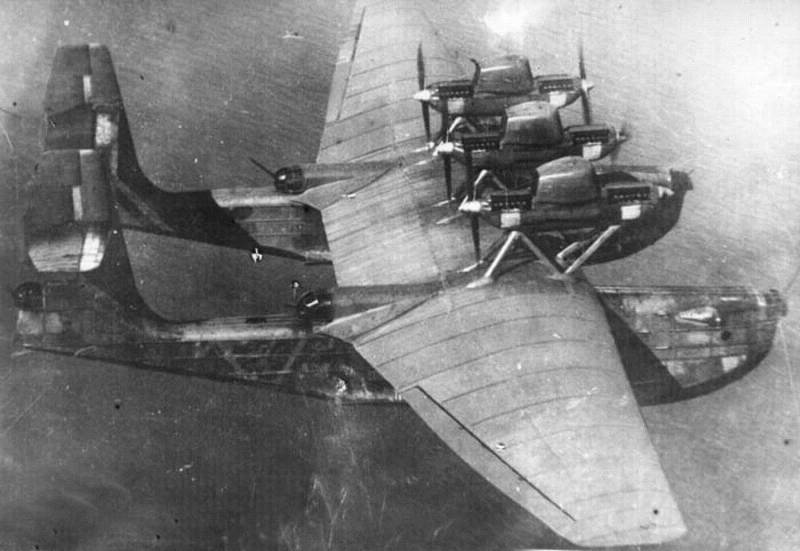
At one time, I was very interested in the biography of the great Soviet aircraft designer Robert Ludwigovich Bartini. Only after learning about the VVA-14 seaplane created under his leadership, about the design of this machine, the tasks assigned to it, and having superficially familiarized myself with his biography, I realized that this is one of the most interesting people in stories aviation. And a lot has already been written about the aircraft that were created under the leadership of Bartini, not to mention documentaries about Bartini himself, which are innumerable.
But the charm of his story was just in the riddle of the name of the aircraft designer, in participation in such projects as the PS (“Transparent Aircraft”) and the four-engine R-114 jet fighter. But his story was overgrown with more and more little things, as well as important and fundamental details from his life, and the image of the "Soviet Aviation Woland" began to change.
In my understanding, Roberto Bartini is a great aircraft designer who created very technologically advanced and, from the point of view of the layman, beautiful aircraft, but there were no inexplicable secrets in his fate, which seemed to be the main ones in the work of this engineer. And, as for me, fighters, seaplanes and ekranoplanes created by Robert Bartini are the more interesting part of his life. And those who were also interested in this topic could hear that even before the start of the Great Patriotic War and before his great independent activity, he participated in the creation of one large hydroplane, which was never put into service.
But the history of this as yet unnamed aircraft turned out to be much more interesting, and the participation of Roberto Bartini in the design turned out to be not so significant.
So, this is the story of the Soviet heavy six-engine two-boat flying boat, created under the leadership of Andrei Nikolaevich Tupolev, the MK-1.
And, as you can already understand, the creation of the MK-1 was the result of the work not only and not so much of Roberto Bartini, but also of one of the most important people in the history of Soviet aviation - Andrei Tupolev.
Moreover, the history of MK-1 will affect the work of a large number of people and organizations. Here are Bartini, and Tupolev, and the whole AGOS - a little-known, but important design bureau in the pre-war period. In total, in the creation of this seaplane from three different persons or organizations, three versions of the design will appear that meet the tactical and technical requirements for a heavy naval bomber.
And we will start with the version that was created at the AGOS Design Bureau, because, judging by the book by Vadim Borisovich Shavrov “The History of Aircraft Designs in the USSR until 1938”, to which we will often refer, it was there that the discussion of the aircraft first began, which later after numerous tests, in which a huge number of people participated, it became known as MK-1. They became a seaplane, called ANT-11.
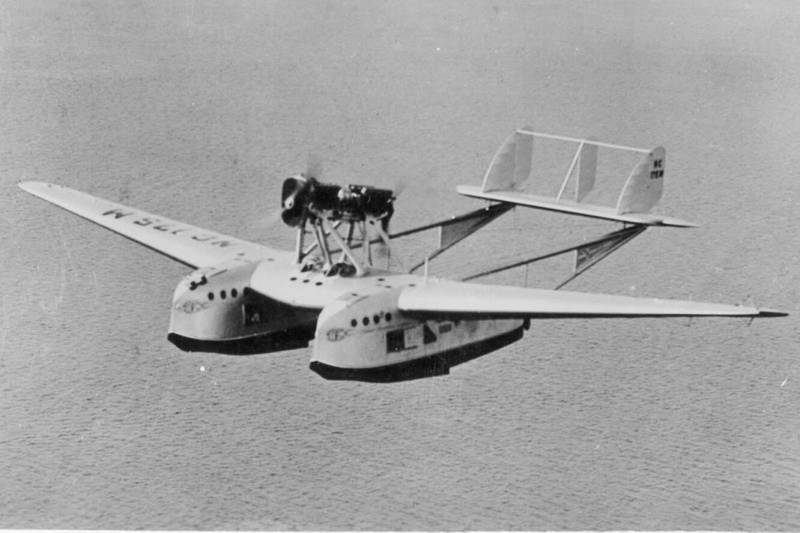
But before we move on to it, let's dwell on one such important and interesting nuance as the operation of aircraft similar to the MK-1.
Yes, the design of a two-boat seaplane, or a catamaran, was previously worked out on other aircraft. First of all, I would like to recall, of course, the Italian Savoia-Marchetti S.1920 seaplane, famous for its advertising flights in the 55s, designed by Alessandro Marchetti in 1922. In 1929, a squadron of such machines under the command of Colonel Balbo visited Odessa, where the S.55 was clearly demonstrated to Soviet aviation specialists.
The result of the demonstration and related negotiations was the purchase in 1932 by the Soviet Union of six S.55s, five of which were later operated on the Far Eastern lines of the Civil Air Fleet.
The Italian catamaran, the significant flight of a squadron of these seaplanes, and the operation of the S.55 directly in the USSR may have influenced the interest in this design among Soviet aircraft designers. At the same time, we are talking here not only about seaplanes, but also about ships in general.
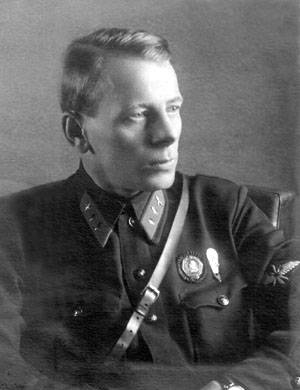
In the first half of the 1930s, the project of a combat and passenger catamaran was developed in a special design bureau of P. I. Grokhovsky, which was built at the Sevastopol aircraft plant No. 45 (known as the glider of the 45th plant). After testing an experimental two-boat 16-seater glider A-13, in 1936, the development of a giant catamaran-glider ZIG-101, accommodating 150 people, was carried out.
The ZIG-101, designed by engineer V. A. Gartwig, was intended for high-speed maintenance of the Sochi-Sukhumi line. Its “aircraft” component was that the ZIG-101 was to be built by aircraft factory No. 1.
All this, with minor changes, was taken from the article by Mikhail Maslov and Vadim Egorov "The Black Sea Giants", whose work I will refer to in the future. However, already now from this large insert one can draw a conclusion on what my attitude is to the work of these two respected authors.
Anyway, despite the fact that in their work the story is concentrated on two-boat catamarans, I will focus on another topic stated in the title and brief description, so now we move on to the history of one of the first reflections on the "Sea Cruiser" - ANT-11 .
ANT-11
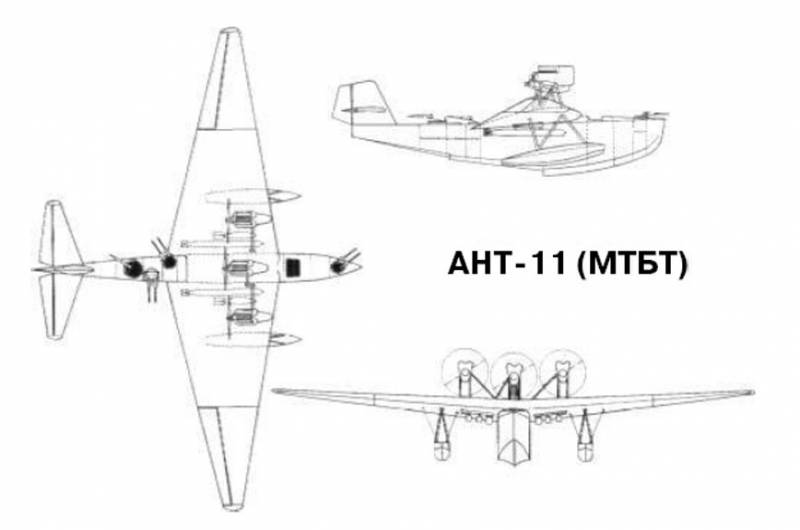
ANT-11 was a response to the need of the Navy to strengthen the naval aviation of the USSR. In March 1923, a program for the development of a series of seaplanes for various purposes was approved, but already in 1925 this program was significantly expanded to include several new types of aircraft for that time.
One of these aircraft was the so-called "high seas scout", for which Andrei Tupolev and Dmitry Grigorovich prepared their projects. They were ANT-8 or MDR-2 and ROM-1 or MDR-1, respectively, from each of these aircraft designers. Subsequently, it is on experience in the design and operation of the Tupolev MDR-2 that they will rely on when creating the MK-1.
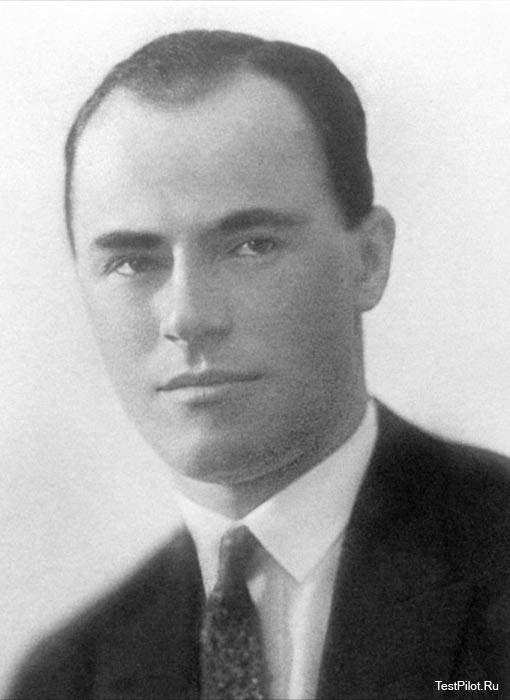
And here it will be important to make a small remark, just related to the question of who participated in the creation of the MK-1.
We are talking about Ivan Ivanovich Pogossky - a calculator, designer, tester, head of the ANT-9 project, the first assistant to A.N. Tupolev in the creation of seaplanes, a student of Nikolai Yegorovich Zhukovsky himself, head of the seaplane brigade (1932). He, along with Andrei Tupolev, will also participate in the creation of the MK-1. Ivan Pogossky turned out to be an aircraft designer who played one of the most important roles in the design of the MK-1.
That is, already now in the history of this project we can see three names of aircraft designers who were directly involved in the design of this seaplane: Bartini, Tupolev, Pogossky.
November 9, 1928. The Scientific and Technical Committee of the Air Force Administration approved the assignment for a naval heavy torpedo bomber, that is, MTBT. A flying boat was required with a normal bomb load of 2 kg (with a reloading load of 000 kg) and armament of four DA machine guns (two on two turrets with a margin of 2 discs for each). Provision was made for the suspension of bombs with a caliber of up to 400 kg inclusive. Alternatively, the vehicle was supposed to carry two TAN-12 or TAN-1 torpedoes, which were dropped separately or in one gulp.
Very high demands were placed on the seaworthiness of the boat. The military demanded to ensure landing in the open sea with a wave of up to 2 m. They intended to provide stability with side sponsons (like the German aircraft Dornier Do 16 (then Dornier Do J), which was in service with us under the designation DV). Sponsons are large, thick, short wing-shaped protrusions at the waterline.
A crew of six was planned: a commander relieved of other duties, a pilot, a navigator (he is also a scorer, torpedo operator, radio operator and photographer), a flight mechanic and two gunners. It is interesting that the pilot was provided for one, but the control is double. The second (switchable) steering wheel, if necessary, was to be picked up by a mechanic sitting next to the pilot.
The exotic of the task was the item on removable sailing weapons. The designers had to design a telescopic mast and everything else that was required for movement under the wind (taken from Vladimir Kotelnikov's book "Giant Aircraft of the USSR"). An aircraft according to this specification will be developed at AGOS starting in 1929.
There are two designs for this aircraft, and both are quite attractive.
According to the first, taken from the book of Vladimir Kotelnikov, a four-engine monoplane catamaran was supposed to turn out. The stabilizer was movable, allowing you to change the installation angle in flight. Sponsors in this version were not needed. Stability was ensured by the distance between the fuselages.
An alternative option was a single-boat seaplane, similar to the MDR-2. Its design is detailed in the book "Seaplanes and Ekranoplans of Russia", written by Gennady Fedorovich Petrov, and there is an image on which this aircraft is illustrated. The author speaks of the ANT-11 as a flying boat with side floats or sponsons for lateral stability. It also provided for the placement of a telescopic mast for installing a sail. The plans included the use of a “stabilizer that could be moved in flight” and electric heating of the torpedo throwers.
One way or another, of both design options, the most important conclusion for us is that when creating the MK-1, Tupolev, Pogossky and / or Bartini could look back at the MTBT design and ask for project documentation for a sufficiently large and heavy “flying boat”. The only thing that changes from the actual design of the ANT-11 is the overall contribution to the development of the future MK-1.
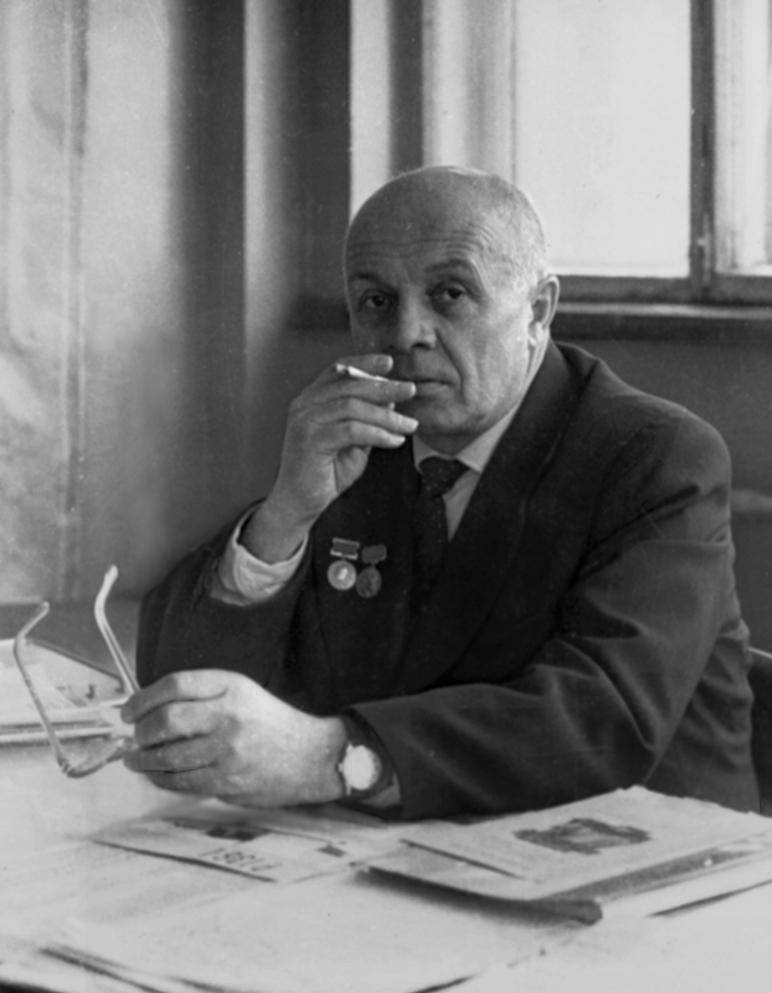
Meanwhile, an important remark that will be required in any case.
In the book of the aircraft designer Leonid Lvovich Kerber there are several pages that are devoted to the development of the MK-1, where it is said that not only Tupolev, but also Pogossky participated in this project. And there is a line stating that aircraft designers fought for many days over the layout of the MK-1, never coming to an ideal option. And many may wonder why they worked on it for so long, if back in 1929 the ANT-11 appeared, which, perhaps, was in many ways similar to the MK-1.
In fact, everything is quite simple. Answering the question whether it is possible to create a new aircraft using only the old design, one should answer unequivocally - of course not.
Not only did these machines have a different number of engines: the ANT-11 had 4, and the MK-1 already had 6, which immediately leaves a huge imprint on the design of the aircraft, but also the tasks assigned to these aircraft differed . MK-1 and ANT-11 are literally different aircraft, and the fact that one of them was created earlier should not force us to be categorical and label. The design of the MK-1 still required a huge number of man-hours.
You can also remember that the MDR-2, created five years late, became obsolete during the first flight, which is why it could not be sent into serial production. ANT-11 in comparison with MK-1 was late for 2-3 years, plus two more, which were required for the full-fledged design of the aircraft.
That is, when the MK-1 was created, the ANT-11 was already an obsolete aircraft that was not suitable for the role of an example to follow. Another project already existed for this role, although we also do not know whether Pogossky and Tupolev relied on it when creating the MK-1 or not.
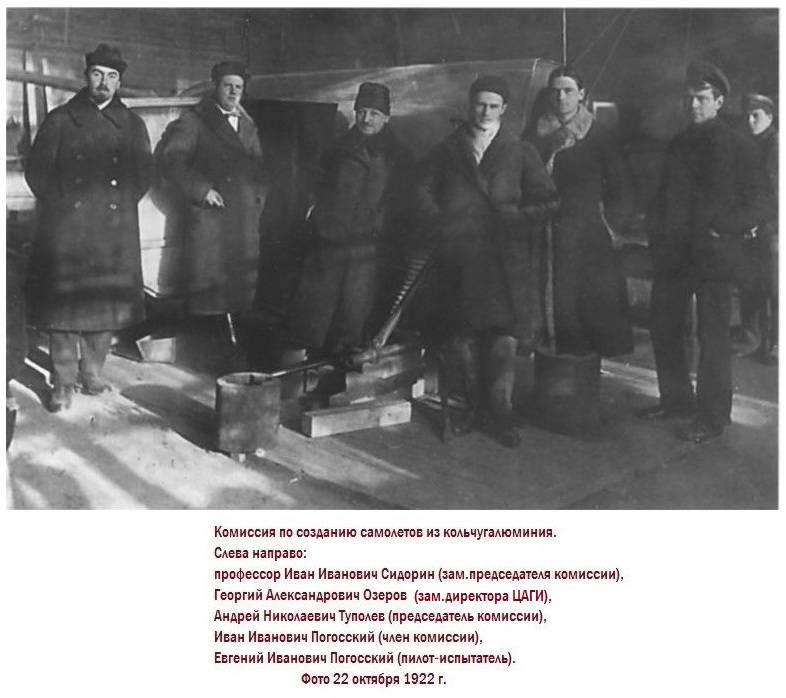
Summarizing what has been said, I would like to say that Ivan Pogossky undoubtedly knew about the ANT-11 seaplane, at least this corresponds to his position and to the maximum he could participate in it, which means that during the subsequent creation of the MK-1 this could help him. One way or another, it would be wrong not to mention the ANT-11 in history, because thanks to this aircraft we will also be able to compose the general context of those events.
And, continuing this logic, we need to talk about another seaplane, which Ivan Pogossky and Andrey Tupolev could turn to when developing the MK-1.
They could, but were not obliged to do this, because before the design of the MK-1 they could come on their own. This is not to mention the fact that Tupolev and Pogossky could also be sent to another impressive two-boat seaplane developed by D.P. Grigorovich in 1925–1926, called MMI, but still such an idea was hatched not only in the minds of these aircraft designers, but including the creators of the MK-1. Be that as it may, it would be a lie on my part to say that this article was not started in order to once again talk about the projects of Roberto Bartini.
MTB-2
So, now we move on to another representative of the breed of huge flying catamarans - the MTB-2 seaplane.
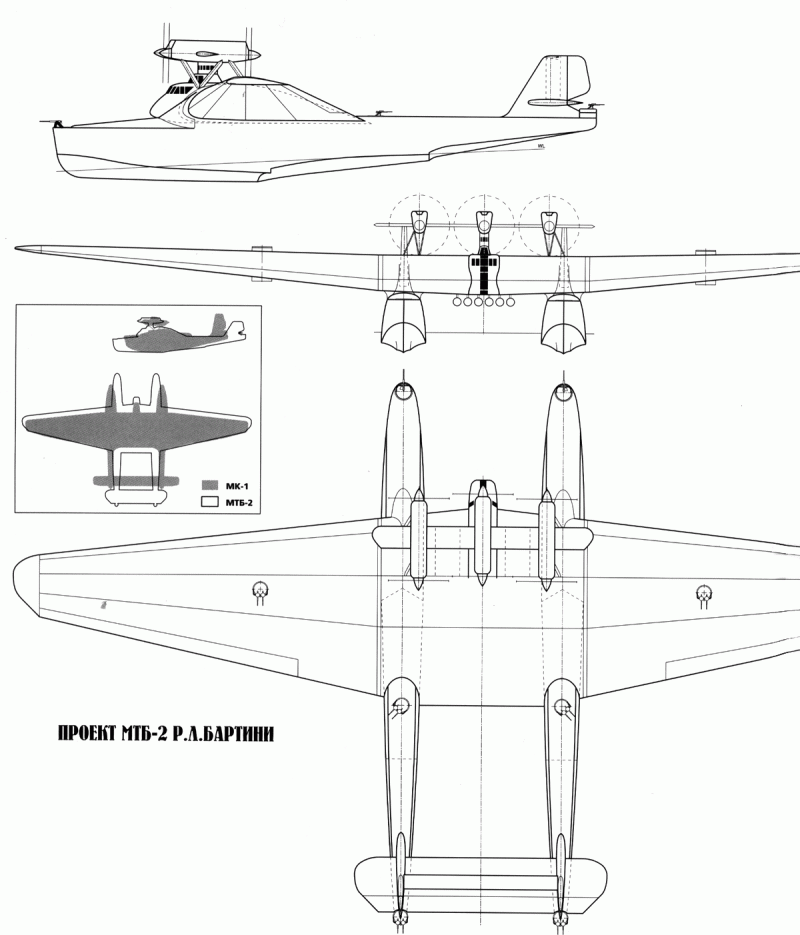
First of all, the name MTB-2 refers us to a naval heavy bomber, but created at the Tupolev Design Bureau, which they called ANT-44.
Actually, if you have a desire to look for this aircraft, you will first find the ANT-44 rather than the Bartini seaplane. Meanwhile, this name is often attributed to the project of the Italian aircraft designer, including such information is found in the book of the remarkable writer Nikolai Vasilyevich Yakubovich. True, there the plane designed by Bartini is simply called MTB, without the number "2" at the end.
And, perhaps, I will quote the words of an eminent author in my article, because somehow it’s hard to say better, and I don’t see the point in reinventing the wheel in this particular issue:
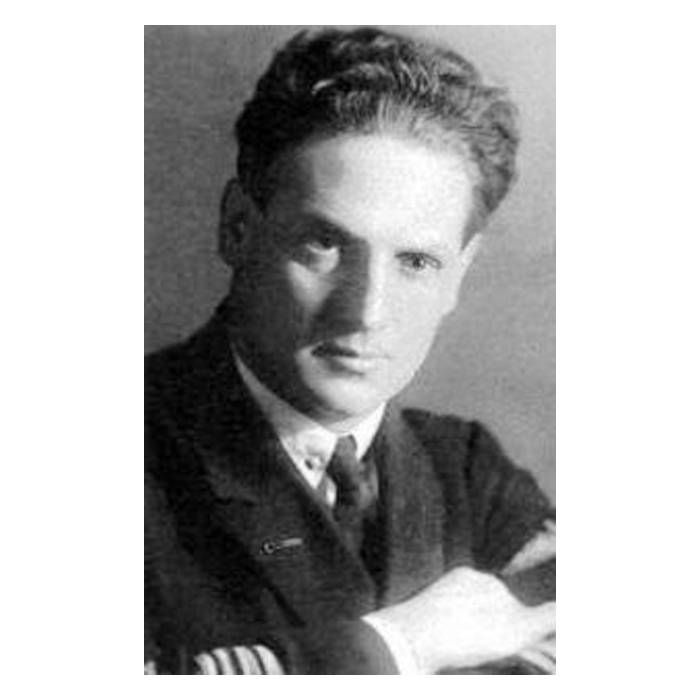
Experts immediately noted the originality of the technical solution - to place four motors in pairs in the wing, moving the propellers forward on elongated shafts, which made it possible to improve the aerodynamics of the machine. Today, in a number of publications, one can find the assertion that not only the idea of \uXNUMXb\uXNUMXbthis machine, but also the technical solutions embedded in it, were borrowed by A.N. Tupolev.
I think that this is not true, and not only because of the lack of documentary confirmation of this, but also because technology develops according to its own laws that determine the similarity of certain technical solutions.
I don’t see the point in talking about the positive qualities of MTB, about which there is a small part in Yakubovich’s book. Nikolai Vasilievich's book was devoted to Roberto Bartini's aircraft, and my article is about the MK-1, so what looked organic in his work will look foreign in mine. And I prefer to leave the analysis of the design for the last.
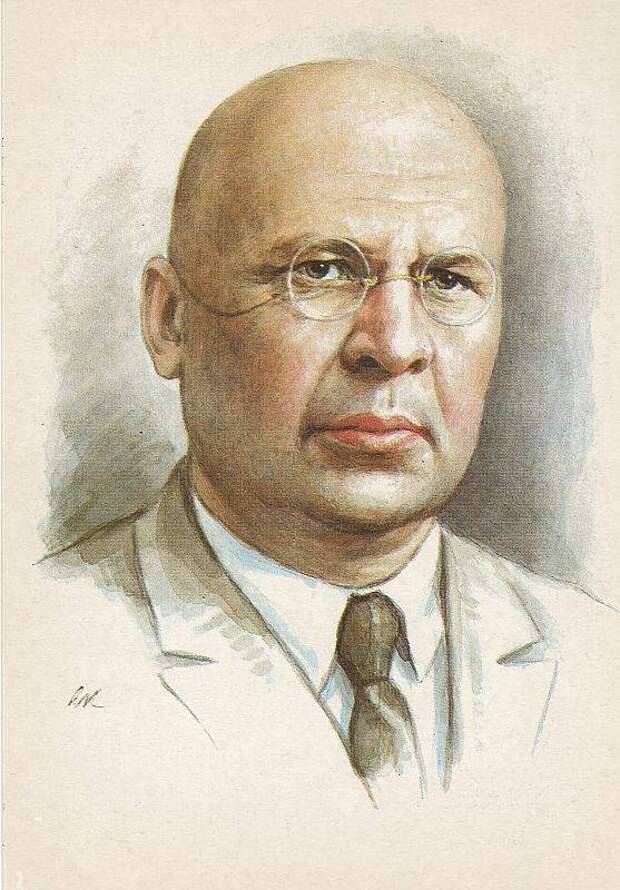
Speaking about whether the Sea Cruiser project could have ended in the triumph of Roberto Bartini, the majority answers no. And this is curious, because one illustrious aircraft designer D.P. Grigorovich in 1930, when the issue of working design of the MTB seaplane was being decided, recognizing the professionalism of the young Bartini, unexpectedly for many said: “I won’t be able to explain why, but I feel: what offers Bartini is correct. It was a high assessment of the venerable designer.
Meanwhile, the MTB was never destined to appear, and the following are most often added to the arguments why this did not happen: in order to achieve the construction of such a huge aircraft, at first Bartini had to “sprout” in the aviation industry. Organize your own design bureau, achieve a production base (that is, gain a foothold in some aircraft factory), prove yourself successful in the implementation of smaller designs, enlist the support of one of the Soviet bosses. R. L. Bartini, after several successful years of service in aviation on the Black Sea, had only recently ended up in Moscow (although he had worked here for some time before the Black Sea business trip).
In 1930, he had neither sufficient connections nor opportunities. After 1930, when he met Grigorovich, such an opportunity appeared, but by that time the project had already been taken up with an iron grip in the Tupolev Design Bureau, which, moreover, had much more confidence.
By the way, Bartini and Grigorovich really found each other. In addition to the already stated phrase about MTB, said by Dmitry Pavlovich, there is a phrase by Robert Ludwigovich about the famous aircraft designer:
As a result, the MTB-2, which really needs to be called the MTB, turned out to be a good help in creating the MK-1, which was worth telling about in this story, but which was not one hundred percent likely to be used by Pogossky and Tupolev. They, no doubt, could use the work of Bartini, but it was hardly fundamental. For this, a full-fledged new project was needed, and not the processing of MTB and ANT-11.
Let's supplement this with the fact that the design of both aircraft still differed in details from the MK-1, so the question of our own painstaking design of a new seaplane was still acute.
So we smoothly approached the version of the Sea Cruiser, designed by Tupolev and Pogossky.
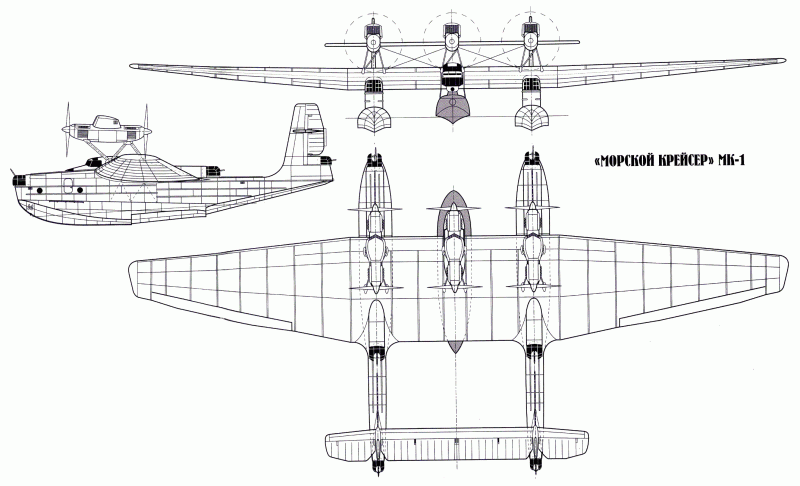
Requirements
Let's return to the history of the tactical and technical requirements for the future MK-1.
Just as the name of the future aircraft differed from the names of other seaplanes, the laconic requirements for this aircraft also stood out.
The project was developed in 1929–1930 in accordance with the TTT for the “Heavy marine torpedo bomber MTB of a boat type of a metal structure for 6 M-34 engines with a total power of 5 hp. With.".
The purpose of the aircraft was defined as “... the destruction and destruction of enemy ships when they are parked at bases and on a trip to the sea. Base destruction fleet enemy and its fortified coastal areas. Facilitate the landing of their landings and support their army operating off the coast.
The method of application is "... flying both in a group and alone, the battle is defensive, based on the maximum use of the firepower of one's weapons."
The sequence of requirements according to their degree of importance is quite in the spirit of that time: carrying capacity, range, fire "independence" (i.e., spherical fire), seaworthiness, and in last place - horizontal speed. Bomb load up to 3 kg, crew up to 200 people. The payload consisted of various combinations of 10, 100, 250, 500 and 1 kg bombs.
The requirements specifically stipulated the placement of bombs with a caliber of up to 250 kg inside the boat in cassettes, with dropping through hatches in the bottom or sides of the boat. In addition, “... instead of the bomb load, the location of a special dropped load should be provided, the weight of each object is 1, 000, 1 kg. The installation of these weights must be agreed with the Ostekhbyuro.
The defensive armament of the future MK-1 consisted of a 20–37 mm automatic cannon on the nose turret, a pair of 7,62 mm DA machine guns on the rear turret, and another DA in the tail turret. In the reloading version, two retractable turrets were added - on the right and on the left wing, with one YES machine gun in each. MTB-2 under normal load was supposed to have the following flight data: horizontal speed of at least 200 km / h at an altitude of 3 m at rated engine power.
The flight range is 2 km at a combat altitude of 400 m at an operational speed of 3 maximum. Landing speed - no more than 000 km / h. Takeoff time - no more than 0,8 seconds. Permissible planning angle is at least 100°. Particularly stipulated was the possibility of continuing the flight with one or even two stopped engines.

A more concise definition of the TTTs presented to MK-1 is set out in the book of the previously mentioned Leonid Kerber. It sounded like this:
At the same time, a completely different description of these events is described in the book of Vladimir Kotelnikov. It sounds like this:
And now is the best time to talk about what class the MK-1 should be attributed to.
Now, after a large part of the TTT presented to this seaplane, one can easily see that in its role this machine can be defined as a sea cruiser, the purpose of which was reconnaissance of remote areas of the open sea, fleet escort, bombardment of enemy bases and fortified areas. That is, the MK-1 was intended to solve the entire range of tasks previously assigned to various long-range naval reconnaissance aircraft, bombers and torpedo bombers being designed and under construction.
At its core, it is a universal technique capable of effectively performing the functions of the MDR-2 and ANT-11. That is, it is possible to call the MK-1 a “heavy attack flying boat”, as Wikipedia did, especially since such a class, apparently, is unique, but the name “sea cruiser” is also appropriate and fully identifies the requests of the military. And, probably, more representative in the context of the tasks of this aircraft.
From July 1931, apparently, they did not count on the MTB project so much, giving their sympathy to the aircraft designer, who was behind the creation of a powerful, efficient team and his own economy in the form of pilot production, etc. - Andrey Tupolev.
Step by step, the design department of TsAGI increased its capabilities and, accordingly, built ever larger and more labor-intensive aircraft, thanks to which they were one of the few enterprises in the country that had enough competencies to implement the MK-1, which had already managed to get the second name ANT inside the design bureau -22 (traditionally, new aircraft created by TsAGI were designated by the first letters of the name of Andrey Nikolaevich Tupolev).
Optimal Design Solution
Design progressed slowly, commensurate with the complexity of the project. The process of thinking and searching for the optimal design began at the end of 1932 by Ivan Pogossky and Andrei Tupolev. In the book of Leonid Kerber, already mentioned several times, there are such lines:
To combat this, there was only one way: to place support floats at their ends. But for such a huge machine as the MK-1, these floats acquired such impressive overall dimensions that they inevitably led to a noticeable loss of speed and, probably, would have made it harder to control the machine along the course.
Moreover, I was also worried about the strength of the wing: on a shoulder of 25 meters, the impact of a one and a half meter wave created a very solid dynamic load.
As it often happens, it (the solution for the optimal design) came unexpectedly - a catamaran! It is impossible to establish now which of them was the first to submit this idea (Pogossky or Tupolev), but the layout went much easier and more productive.
The catamaran has two boats. They were covered with a wing, over which two tandem-mounted six AM-ZR engines were placed in three gondolas. The wing, supported by two boats, did not need floats.
The solution found saved the designers, if not from all, then from most of the difficulties that had previously arisen. A glazed cockpit extended forward from the middle part of the wing. Riflemen with their cannons and machine guns were placed in both boats.
And already now one interesting argument can be made in favor of the two-boat scheme, which Leonid Kerber did not mention. It still rests on the TTT, because the MK-1 initially had additional tasks - the transportation of bulky cargo, including sabotage in the form of small submarines and semi-submerged torpedo boats. For this role, the design chosen by Tupolev and Pogossky was better suited than others.
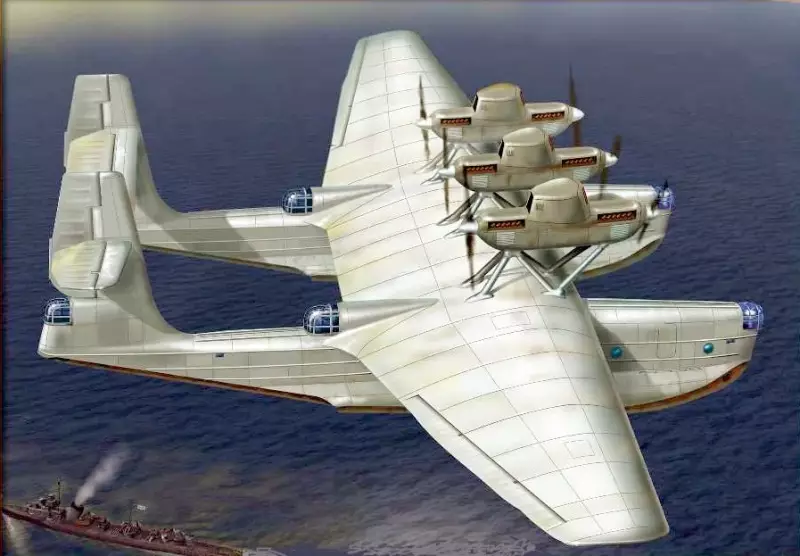
The two-boat seaplane, which at TsAGI received the second name ANT-22, became the third flying boat designed and built at TsAGI. Its predecessors were the twin-engine ANT-8 (MDR-2) in 1930 and the three-engine ANT-27 (MDR-4) in 1934.
As Leonid Kerber assures us, the design of the MK-1 by the Pogossky brigade began in January 1933. That is, Pogossky and Tupolev completed their part of the work on the design of the MK-1, on finding the optimal design for it, in about a month.
We do not know when the construction began, but the design of the ANT-22 could not drag on for a long period, and therefore it is already possible to announce the transition of the creation of the "Sea Cruiser" to a new plane - the construction of the first flight prototype.
construction
The construction of the MK-1 seaplane was carried out in the workshops of the TsAGI experimental designs plant (ZOK TsAGI). This was a new and very large aircraft factory, built almost in the center of Moscow, on Radio Street behind the KOSOS building, in a lowland along the bend of the Yauza River. It entered service on January 1, 1932 (since the middle of 1937, aircraft factory No. 136).
At the beginning of 1934, the production of MDR-4 (ANT-27) was completed here, and by the middle of the year MK-1. On April 15, 1934, when trying to make the first takeoff, the MDR-4 crashed, which imposed a special morale during the tests of the MK-1, and therefore preparations for them were carried out especially carefully. The head of the brigade, I. I. Pogossky, died in the crash.
After him, brigade No. 2 and fine-tuning the MK-1 was headed by Alexander Petrovich Golubkov, who would later lead the design of a flying boat, and initially an amphibian - ANT-44 or MTB-2. Among other famous aircraft, in the creation of which he took an important part, one can single out the Li-2 and Tu-104.
One can argue about the deadlines for completing the construction of MK-1.
On the one hand, there is a book by Vadim Shavrov, which gives clear information that the construction was completed by August 1934. And on the other hand, Kerber's book, which gives a more streamlined formulation that the MK-1 was ready in July, without specifying: at the end (which corresponds to Shavrov's assessment), in the middle or at the beginning. Of course, this is a trifle that you should not find fault with, but it is quite interesting to notice similar formulations yourself, in which there is room for discrepancies.
Meanwhile, factory tests in any case began on one specific date - August 8, 1934, when pilots T.V. Ryabenko and D.N. Ilyinsky first took the MK-1 into the air. Factory tests continued until May 8, 1935. For a long time, a lot of information about the MK-1 has been clarified.
The overall assessment of the aircraft with a flight balance of 31,5% was quite consistent with the standards, with a balance of 34,8–35%, according to the pilots, there was some delay in the actions of the rudders. In terms of flight sensations, it was stated: "The controllability of the aircraft with various combinations of engine operation should be recognized as good."
The maximum speed at the surface of the water was 233 km/h, at an altitude of 3 m - 000 km/h. The practical ceiling of 207 m was gained by the aircraft in 3 minutes, the turn time was 500–57 seconds. The tests were worth continuing.
Subsequently, a standard set of equipment and weapons was installed on the MK-1, after which the MK-1 underwent a full cycle of state tests in the period from July 27 to August 15, 1935.
With external suspension, the data slightly decreased: the maximum speed at the surface of the water was 205 km/h, cruising - 180 km/h, service ceiling - 2 m.
Hydrochannel
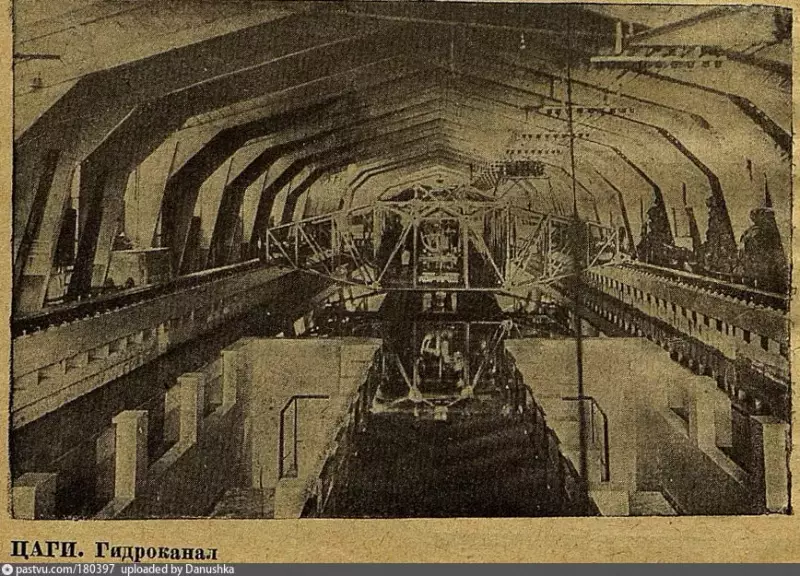
But what turned out to be excellent was the seaworthiness of the MK-1. The notorious hydrocanal, built and put into operation in the 1930s, exactly with the creation of MK-1, began to bear fruit. About his participation in the creation of MK-1, let's turn to the text of Leonid Kerber:
By slowly lowering the model during the movement of the trolley, which is gradually slowing down, as during landing, it was possible to imitate the landing itself.
Here is the MK-1 model touched the water surface of the canal. At first, the keels of her two boats drew two thin strips on the smooth surface of the canal, then both boats sank and raised a lot of spray. The model slowed down.
It was incredibly clear and convincing.”
That is, the well-known hydrochannel among aviators managed to participate in the creation of the MK-1, and, as follows from the closing words of Leonid Kerber, he showed himself successfully.
New technologies are almost always a good thing, and it's great that the hydrochannel allowed us to speed up the creation of the MK-1, making it a more efficient type of vehicle.
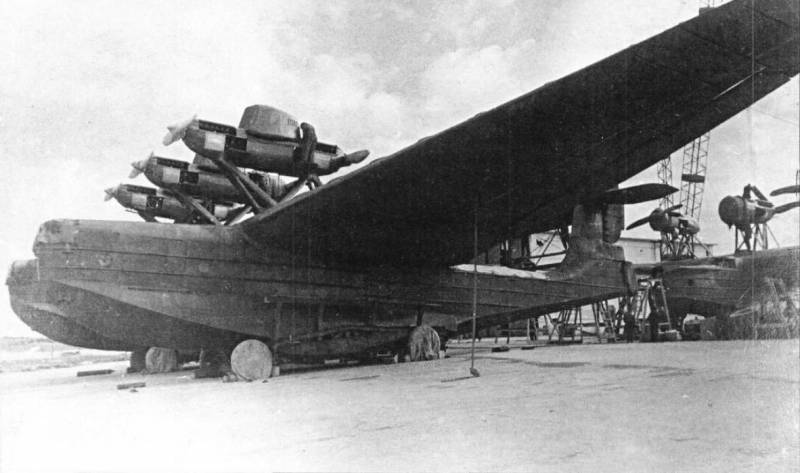
After state tests and evaluation of the MK-1 in the hydrochannel, it was found that, in terms of its seaworthiness, the MK-1 has good contours and hydrodynamics, is able to take off and land in the open sea with a wave of up to 1,5 meters and a wind of up to 12 m / s. At the same time, the indicators of speed, ceiling and flight range (1 km) did not meet the requirements of the time.
It was proposed to continue improving the aircraft, for which purpose to install more powerful M-34RN or M-34FRN engines. And if the first one was not slightly more powerful than its progenitor, the M-34R (short for "gear") with a capacity of 750/800 hp. With. (according to Genadi Fedorovich Petrov - 750/830 hp) and 750/820 hp. With. at the M-34RN, then the M-34FRN could improve the necessary characteristics of the MK-1.
According to the project, its power was equal to 1/050 hp. s., this is a large increase in comparison with the M-1R, but during tests it was found that in fact it is 200/34 liters. With. That is, the installation could help the MK-900 a little, but there were already so many problems around this seaplane that the new engine could not allow it to go into mass production.
As we know, by the middle of 1935 interest in the MK-1 faded. The reason for this was not only the new tactical and technical requirements for combat seaplanes, based on the progress of aircraft construction around the world, which the MK-1 could not keep up with, but also the circumstances of exceptionally practical use.
Maintaining such a large aircraft required a correspondingly large amount of technical equipment and ground personnel. Preparation for the flight and its support itself turned out to be too complicated and long. MK-1 has ceased to justify the hopes invested in it.
The same reason, but in more detail, was revealed in his book by Leonid Kerber:
Several circumstances contributed to the adoption of such a decision: the reliability of aircraft increased, and there were isolated cases of forced landings. It should not be forgotten that with unification it was possible to sharply increase the production of cars.
In other words, the MK-1 was in the wrong place at the wrong time, although it could never appear again. True, the country where the MK-1 was created fades into the background when you realize in what context of time this aircraft developed. The widespread development of the aircraft industry in the 1930s approved many ideas that previously seemed little feasible.
On the other hand, if the MK-1 were created, for example, in Sweden in the same period of time, then it would definitely become successful, but the fact is that Sweden did not have a strong aircraft industry then, and the MK-1 was not created from a vacuum. Behind the appearance of this machine are thousands of man-hours and many aircraft, without which it is hardly possible to imagine the MK-1.
And so it turns out that in the main problem of this seaplane “at the wrong time, but in the right place”, after all, time turns out to be a more important parameter. Here it would also be interesting to somehow drag in the theory of the six-dimensional dimension, which was presented by Roberto Bartini, but it's time to finish with these thoughts aloud.
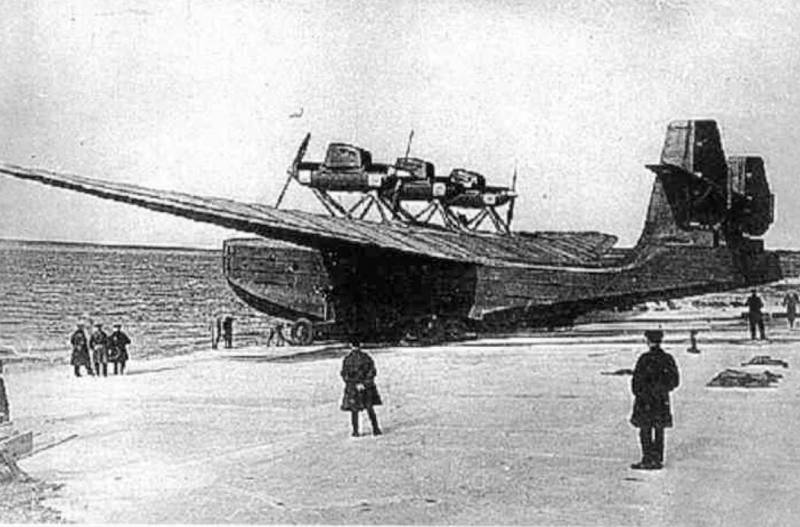
The program for the creation of the MK-1 was not delayed, just progress in the aircraft industry forced, and rightly so, to abandon the six-engine hydroplane. Be that as it may, this seaplane flew until 1937.
It is not known whether experiments were carried out on it with the transportation of small "semi-submerged" boats, in which the ships themselves, rather than a seaplane, would have been the subject of the test. However, the fascination with MK-1 records did not bypass. Given the situation around this aircraft, it is unlikely that history could have taken a different path.
And for engineers, the situation, on the contrary, is favorable - you can try a huge, already tested, six-engine hydroplane with high hydrodynamic characteristics in your needs. On December 8, 1936, pilots T.V. Ryabenko and D.N. Ilyinsky reached a height of 1 m on it with a load of 942 kg. On the next flight, it was possible to lift the maximum load of 10 kg.
There is an opinion that this is a world altitude record on a plane that was relevant for that time, but this information appeared in the book of Gennady Petrov, who, apparently, relied in his monograph on the book of Vadim Borisovich Shavrov, where more accurate data on the cargo carried by the MK -1 but no world record fact.
Meanwhile, the history of the MK-1 and the idea of creating something similar continued to torment aircraft designers even after the closure of the Sea Cruiser program.
In 1938, TsAGI was researching a four-engine, two-boat seaplane with a take-off weight of 54 tons. A feature of this project was the asymmetrical cross-section of the boats, which made it possible to reduce spray formation during take-off. The work remained in the category of experimental studies.
And maybe such a project really existed, who knows now, but I personally could not find information about such an aircraft in the books of the authors that I referred to above.
Perhaps he was, and it is likely that the authors of a large article in the Military Review, namely Mikhail Maslov and Vadim Egorov, found something that I did not find. Moreover, among them, the first one for me is a familiar author: I liked his book “Stalin's Flying Aircraft Carriers”, dedicated to the “Link” project, which was led by Vladimir Sergeevich Vakhmistorov. Unfortunately, on December 8, 2022, at the age of 68, he passed away. It is very unfortunate that a person who appeared to me as a specialist of the highest class has died. And if I learned about Mikhail Maslov even before I started writing an article about MK-1, then Vadim Egorov is a new person for me.
One way or another, if such a plane existed, then I would be pleased, because it means that there is someone more attentive than me, which means that I have something to strive for.
From myself, I would note that the design of this 54-ton four-engine two-boat seaplane appeared in 2001. And, as the caption on the only image of this aircraft says, this drawing was also described by Vadim Egorov. And, knowing these facts, my opinion boils down to the fact that such a seaplane did not exist in 1938. At TsAGI, by that time, they were already engaged in another project of a large seaplane, called ANT-44, which took off on April 19, 1937, and which took up a large amount of resources.
On the other hand, the ANT-44 was not an aircraft similar to the MK-1, and TsAGI could be interested in creating an updated, more technologically advanced seaplane capable of fulfilling the roles that were laid down in the design of the MK-1, according to its capabilities. Although I may be wrong, and I would be glad to be wrong. In any case, I propose to move on to the design of the MK-1.
MK-1 design
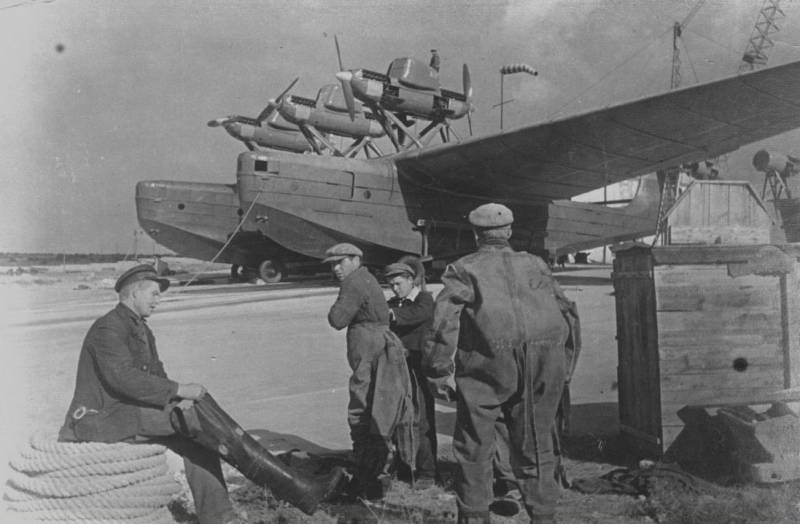
So, MK-1 is a two-boat multi-seat hydroplane, the design of which is adapted for the transportation of mini-submarines and "self-dive torpedo boats", as Gennady Petrov describes them in his book, to the combat area.
Other functions of the MK-1 include: naval reconnaissance in remote areas, fleet escort, bombardment of enemy bases and fortified areas. Well-developed bows of interchangeable boats ensured high seaworthiness.
Equipped with six AM-34R engines in three tandem installations on the center section. The thrust of each is 750/800 hp. With. The propellers are wooden, two-bladed, of the same diameter - 4,2 m. The pitch of the pulling propellers is 3,35 m, the pitch of the pushers is a little more - 3,96 m. Fuel in four gas tanks with a total capacity of 9 liters, oil 500 liters. The four-spar wing, cantilevered with a large elongation, fit into two boats, located approximately 1% of the span of each half-wing. Wing skin is corrugated.
In the tail of the aircraft there is a two-fin plumage. The tail parts of the boats turned into vertical keels. They are connected to each other by a fixed stabilizer, and the stabilizer consoles extending beyond the keels were foldable; in flight, the installation angle could change. The design of the MK-1 is all-metal, previously used by TsAGI: a power set of steel tubular elements, a reinforcing set of duralumin profiles, riveted hull and plumage skin.
We turn to the performance characteristics and performance characteristics of the MK-1, which turned out to be quite impressive.
So:
Wingspan, m: 51,6
Aircraft Length, m: 24,1
Wing area, m: 2
Aircraft weight:
Empty weight, kg: 21 663
Flight weight, kg: up to 33 560
Maximum speed km / h:
At altitude: 223
Near ground: 205
Cruising speed, km / h: 187
Range, km: 1 330
Ceiling, m: 3 500
weaponry
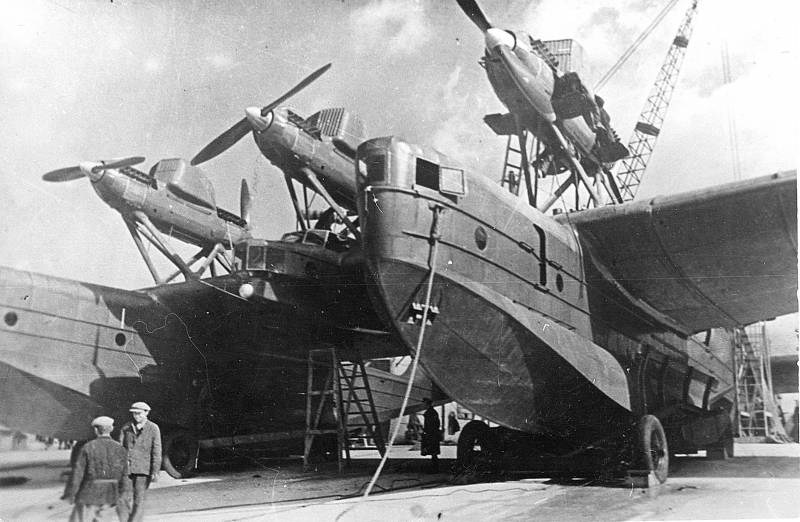
Now let's move on to weapons, which, if you remember, were heavily emphasized when compiling the TTT for the future MK-1.
And the immodest armament of the Sea Cruiser is worth describing in more detail.
In total, the MK-1 had six shielded turrets, three on each gondola. In the left boat, shielded turrets were successively installed: bow with a DA-2 machine gun, rear (immediately behind the wing) with a 20-mm cannon and aft (behind the vertical tail) with a twin ShKAS machine gun of 7,62 mm caliber.
A similar arrangement of turrets was on the right boat, according to Shavrov's book. However, from Petrov's book it follows that all machine guns on the MK-1 were ShKAS models, which may well be true. The maximum ammunition of two guns consisted of 600 rounds, and all onboard machine guns - 14 rounds.
Bombing armament - suspension of up to 6 kg of bombs or four aircraft torpedoes with a total mass of up to 000 kg.
The bombs were placed both inside the intersubmarine center section of the wing, which was an important condition for the TOR presented to the ANT-22, the relative thickness of which is 19,6% and made it possible to equip it with eight bomb bays up to 1,4 m high with KD-2 cluster holders for 32 bombs weighing 100 kg each, and outside - on beam holders designed to hang either six bombs weighing 1 kg each, or 000 bombs each weighing 12 kg, or 500 bombs each weighing 20 kg, or four torpedoes weighing 250 kg each.
The boats are interchangeable, significantly broadened in the lower part, up to the 2nd redan. This each lower part, at the junction with the upper part, had a watertight deck with large hatches for inspection. All seams of these two unused sealed compartments are made with red lead diluted in polymerized oil.
The upper part of the boats, connected by the center section, is in fact a very roomy fuselage, equipped with entrance doors for the crew in the bow area. Each boat has anchors, winches for lifting them, pumps (alveyers) for pumping water. Within the broadened part, each boat could move freely, in addition, it was possible to penetrate through the center section from the left hull to the right and vice versa.
The flight crew consisted of 4 people (the entire crew was 10–12 people): two pilots, a ship commander and a navigator. The workplaces of the navigator, two pilots and the flight mechanic were equipped in the central gondola, mounted on the center section of the wing along the axis of symmetry and protruding beyond its leading edge. The crew's gondola was carried out in two stages to ensure a good view of the power plants in flight, the flight mechanic's cabin was somewhat elevated above the cockpit, and in its upper glazed part there was a hatch for access to the engines.
As already discussed, the right and left boats were equipped with jobs for six shooters and, moreover, in the right boat, immediately behind the front gunner’s cabin, there was a radio operator’s cabin working with the PSK-1 transceiver radio station, with which telephone radio communication could be carried out on a distance of about 350 km.
The MK-1 was also equipped with a 13-PS radio station for driving around beacons, an SPU-7 intercom, an AFA-13 plan camera (under the commander's bridge) and two AFA-15 aerial cameras for perspective shooting, placed in turret mounts.
In addition, in the center section there was a mechanic serving the engine installations, and a toilet for the crew. It feels like something similar was subsequently used on the Lun impact ekranoplan, which, logically, was also built for operation at a great distance. This is not even a coincidence, of course, but simply a logical continuation of previously laid down ideas and a response to requests from the military.
Hack and predictor Aviator
Now I propose to proceed to the conclusion without highlighting one more paragraph to the fact that the MK-1 did not have a wheeled chassis, because it is a hydroplane, not an amphibious aircraft. At least all the important elements of the design have already been covered, and now nothing prevents us from summing up this relatively long story.
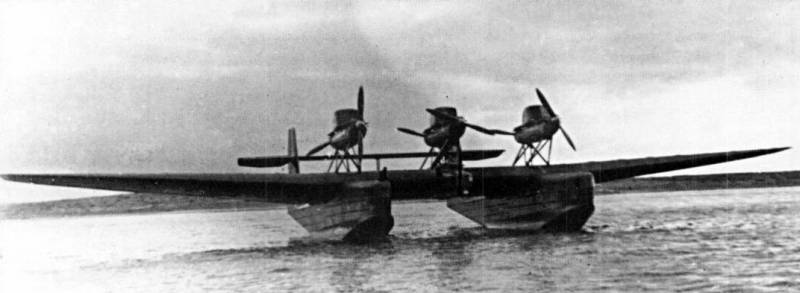
The history of the MK-1 is rather extraordinary.
As I already said, the idea to write about this seaplane came to me after I learned that Roberto Bartini, an aircraft designer, played a role in the design, each aircraft of which is interesting to me. And I met the MK-1 only because he took part in the design. As it turned out, Bartini's role in the creation of the Sea Cruiser was modest.
And when I started writing this article, I did not know about it, it seemed to me that the MK-1 was an aircraft created in cooperation between TsAGI and Bartini, which was not true. Subsequently, after reading specialized literature, getting acquainted with the history of the creation of the MK-1, with the engineers involved in the creation, I realized how wrong I was.
But the real story was no less interesting. As I delved deeper into the biography of the MK-1, I became familiar with many aspects of the Soviet aircraft industry of the 1920s and 1930s, discovered many authors whose books I will refer to later, and eventually discovered the incredibly attractive aircraft created by in those days when everyone in aviation was chasing an increase in mass.
The 12-engine hydroplane Dornier Do X has already taken off, at the same time as the MK-1, the ANT-20 Maxim Gorky, physically the largest aircraft of the 1930s, took off into the sky, but lost 3 tons in maximum takeoff weight to the Dornier Do X, and before that, the sky had already been cut by TB-3 and ANT-14 "Pravda" - also very large aircraft. The creation of each giant aircraft is interesting, including due to the TTT presented to them.
It is interesting to see how flying boats developed rapidly in the years before World War II, how their dominance came to naught, and why aircraft such as the K-7 and the Junkers G.38 were created along with them. Aviation can be simplified in some aspects, but each aircraft still needs to be considered separately. Summarizing, one can make careless, and perhaps even absurd statements, on which I burned myself a couple of times.
Summing up the final result of this article, I would like to note how interesting the history of the MK-1 turned out to be. I really enjoyed collecting all the facts from various books and articles on the Internet. And although the MK-1 is unlikely to ever become a well-known aircraft, and in terms of size it cannot be compared with ekranoplanes and ekranoplanes, which will be handled by R. E. Alekseev, L. N. Schukin, A. K. Konstantinov and Roberto Bartini himself , he will forever remain on my list of aircraft with an interesting fate. But ekranoplan building, as usual, is a completely different story, about which some later.
Information